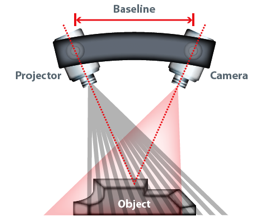

By: Giles Gaskell
This is the third article in our series on the Fundamentals of 3D scanners and 3D imaging technology. It covers the basics of optical scanners and could also save you a lot of money.
If you measure shiny parts, machined metal or any parts that need to be coated and you use (or want to use) 3D scanning technology you’ll want to read all the way to the end.
Laser Line or Structured Light 3D Scanners – Which is better?
People ask me this question at every presentation, and 20 years on, to be honest, I can’t say which is better – Laser 3D Scanners or Structured Light Scanners/White Light Scanners. With certain applications one may be better than the other and have slight advantages. Like so many things in technology and metrology – it depends.
So, let’s cover how they work as a way to ascertain which is best for your needs.
All optical scanners work basically the same way, whether they are laser line scanners, structured or white light scanners.
Laser Line Scanning
Usually the laser is red, but sometimes it may be green or blue. The level of power of these lasers is very similar to the laser you might see in the check out line.
The basic method of operation is the laser beam is played on the object and it moves across the surface in a series of lines and it squiggles. It works by triangulation wherein the laser shines on the object and a camera is picking up the data it delineates.
Structured Light Scanners also called White Light Scanners
Generally speaking these scanners use white light, though they can use blue or other colors – they are known collectively as White Light Scanners.
The way these work is instead of a moving laser line that is being read, the Structured Light Scanners shoot a square patch of light that looks quite like zebra stripes. These stripes then change “structure” or move into a new pattern of zebra stripe which is then read by the camera and the light goes away.

Both of these use triangulation and give highly accurate depth perception for the camera which then equates to very accurate measurements. It’s an obvious way for this to work and delivers excellent measurement accuracy.
There are definitely some drawbacks and problems associated with structured light scanners and laser line scanners though.
One major problem that almost all optical scanners suffer from – they have real difficulty measuring shiny surfaces.
Shiny or reflective surfaces will reflect or disperse the light into all different directions and the camera system is confused and cannot read properly.
How Accurate Does Your 3D Scanner Really Need to Be?
Recently machined metal is in that category. The normal metrological method to fix this is to coat the part with something that gives it a matte finish.
Here’s the scoop, when you do that the accuracy of the 3D scanner you are using is no longer what the manufacturer said it was. The accuracy now is the uncertainty of the thickness of the coating you applied to your part.
The only way to stay within the reported accuracy is if you somehow know that the paint you’ve applied is within a micron of thickness. This unfortunately, is not possible and tests have shown us that the paint thickness could be as little as 10 microns and as thick as 10,000th of an inch – you just don’t know.
Your new uncertainty is no longer tied to the accuracy of the machine you bought, but instead to the thickness of the coating you had to apply.
Got Shiny Parts? Read This & Save Thousands on Your 3D Scanner
This is the little tidbit that could save you tens of thousands to hundreds of thousands when you purchase a 3D Scanning machine – whether it’s a white light scanner or laser scanner. From us or somebody else. It doesn’t matter. The reality is the reality.
If your parts are always shiny and you’re going to have to coat all of them before measuring, then you might as well buy a 3D Scanner that has an accuracy of plus or minus 3 or 4 thousandths of an inch. No higher level of accuracy is warranted. At this point, your benchmark is no longer accuracy.
Get a high value, relatively low cost 3D scanner that’s portable and easy to use and still accurate within the real uncertainty you’re going to be dealing with after you coat the parts.
If you’re coating all the parts before measuring then you’re chasing a level of accuracy that is impossible to achieve anyway due to the need to spray your parts. One of our mantras at Wenzel America is don’t buy more machine than you need. We hope this helps you do that.
About Wenzel America
Wenzel America Ltd. is a wholly owned subsidiary of Wenzel Group of Germany. Contact Wenzel America by phone at 248.295.4300, email us [email protected] or subscribe to our newsletter.
About Giles Gaskell
Giles Gaskell has been involved in industrial 3D Imaging and 3D Scanning since it’s earliest beginnings. He founded the first distribution company for hand-held 3D Scanners in the UK and then Italy. Since arriving in the United States in 2005 he has continuously worked in the 3D Scanning an Imaging arena in business development and education. Giles is 1 of 3 Advisors North American advisors to SME’s RAPID show which is focused on 3D Printing and Additive Manufacturing. Since 2010, Mr. Gaskell has been the Applications and Sales Manager for 3D Imaging products at Wenzel America.
